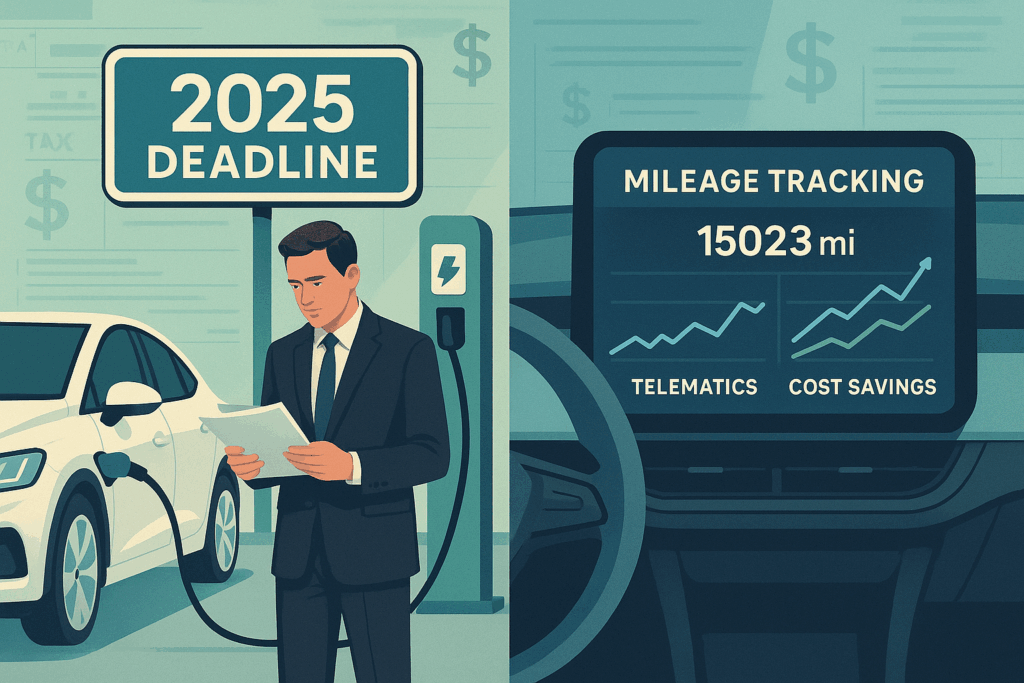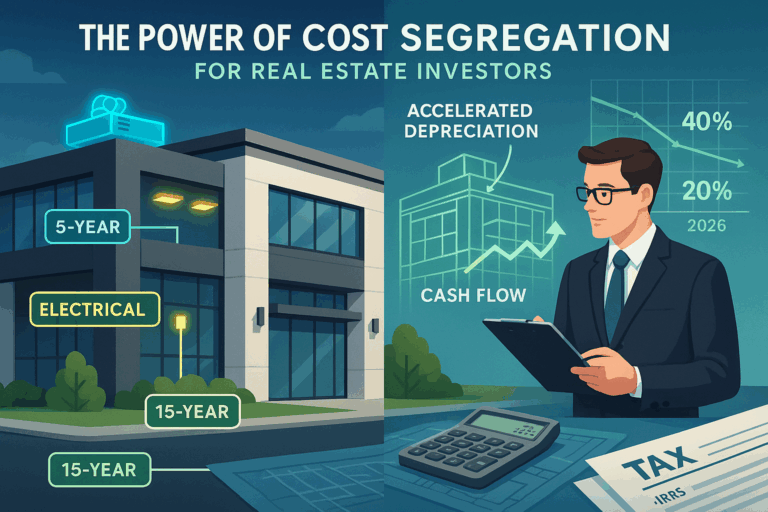Navigating Business Vehicle Decisions in 2025: Tax Incentives, Rising Costs, and Compliance
In today’s economic climate, small business owners face increasingly complex decisions regarding their business vehicles. With rising costs across fuel, insurance, and maintenance, combined with evolving tax regulations and incentives, the right vehicle strategy can significantly impact your bottom line. The year 2025 brings notable changes: the IRS has increased the standard mileage rate to 70 cents per mile, modified Section 280F luxury auto limits, and maintained generous clean vehicle incentives with approaching deadlines. This guide explores how small businesses can optimize vehicle expenses, ensure compliance, and leverage available tax benefits.
Clean Vehicle Incentives: A Closing Window of Opportunity
Small businesses looking to electrify their fleets in 2025 have powerful but rapidly expiring tax incentives to consider. The Commercial Clean Vehicle Credit (Section 45W) faces a critical sunset date of September 30, 2025 [Source: IRA Tracker], while the Alternative Fuel Vehicle Refueling Property Credit (Section 30C) remains available until June 30, 2026 [Source: Electrification Coalition].
For the 45W credit, businesses can claim the lesser of:
- 30% of the vehicle’s basis (15% for hybrid vehicles)
- The incremental cost compared to similar gasoline/diesel vehicles
Maximum credits are $7,500 for vehicles under 14,000 pounds GVWR and $40,000 for heavier vehicles [Source: Cherry Bekaert].
Qualifying vehicles must:
- Be manufactured by qualified manufacturers
- Be used primarily for business in the United States
- Meet battery capacity requirements (at least 7 kilowatt hours for vehicles under 14,000 pounds)
- Be subject to depreciation [Source: IRS]
For charging infrastructure, Section 30C offers a 30% credit up to $100,000 per charging station, covering both equipment and associated infrastructure costs [Source: MGO]. Approximately 99% of U.S. land area now qualifies under rural or underserved community provisions [Source: Crux Climate].
Tax-exempt organizations can also benefit through Elective Pay provisions, transforming tax credits into direct payments from the Treasury [Source: Treasury Department].
Managing Rising Insurance Costs Through Technology
Commercial auto insurance has become a major expense, with premium increases reaching alarming levels. In early 2024, rates jumped between 9% and 9.8%, approaching 10% by year-end [Source: Dom Risk]. This trend continues into 2025, with first-quarter rates showing a 9.4% year-over-year increase.
Driving factors include:
- Widespread driver shortages
- “Nuclear verdicts” with massive settlements
- Inflation affecting repair costs
- Increased distracted driving incidents
Telematics technology offers a powerful solution for controlling these costs. These systems enable usage-based insurance (UBI) that rewards safe driving behaviors with lower premiums. Small businesses implementing telematics can achieve immediate premium discounts of up to 30-40% [Source: Bankrate].
Key safety metrics tracked include:
- Hard braking frequency
- Speed compliance
- Acceleration patterns [Source: McGriff]
Implementation costs typically range from $15-$50 per vehicle monthly for software, with hardware expenses varying by system complexity [Source: Tech.co]. Options include comprehensive fleet management platforms like Samsara, telematics-focused solutions like Omnitracs, or basic GPS tracking systems.
Beyond insurance savings, telematics provides additional benefits:
- Route optimization reduces fuel costs
- Driver monitoring extends vehicle life
- Preventive maintenance scheduling prevents costly breakdowns
- Documentation of business usage for tax purposes [Source: Geotab]
Substantiation and Audit-Proofing Your Vehicle Deductions
Vehicle deductions represent significant tax-saving opportunities but also rank among the most scrutinized areas during IRS audits. With standard mileage rates reaching 70 cents per mile in 2025 [Source: Everlance], proper documentation is essential.
The IRS requires “contemporaneous” record-keeping, meaning documentation must be created at or near the time of each business trip [Source: Geotab]. A compliant mileage log must include:
- Date of each trip
- Starting and ending locations
- Business purpose
- Odometer readings
- Total business miles driven
Additionally, you must maintain annual records showing total business versus personal mileage to establish your business-use percentage [Source: DriversNote].
The 50% business use threshold is particularly critical. Section 179 deductions and accelerated depreciation require your vehicle to be used more than 50% for business purposes throughout its class life [Source: Section179.org]. If business use drops below this threshold in subsequent years, you face “recapture” of previously claimed deductions.
Common red flags include claiming exactly 100% business use, using round numbers for business percentages, showing inconsistent year-over-year patterns, and including commuting miles improperly [Source: JR Martin CPA].
Modern GPS-enabled mileage tracking apps automatically separate business from personal miles while providing detailed documentation. Leading options include MileIQ, TripLog, Everlance, and Fyle [Source: Fyle].
Conclusion
Optimizing your small business vehicle strategy requires balancing immediate tax benefits with long-term operational considerations. The increased 2025 standard mileage rate offers potentially greater deductions for high-mileage businesses, while clean vehicle incentives provide substantial savings before expiration. Regardless of your vehicle choice, meticulous record-keeping remains essential, and telematics can both reduce insurance costs and strengthen documentation practices. By treating business vehicles as strategic assets rather than mere expenses, you’ll maximize tax benefits while building a more efficient and audit-resistant operation.
Sources
- Bankrate – Telematics insurance facing new heat over privacy concerns
- Cherry Bekaert – Section 45W Tax Credit Updates for Commercial EVs
- Crux Climate – 30C Proposed Guidance
- Dom Risk – 2025 Market Outlook Commercial Auto Insurance
- DriversNote – IRS Mileage Log Requirements
- Electrification Coalition – EV and Charging Tax Credits After the One Big Beautiful Bill Act
- Everlance – IRS Mileage Rate 2025 for Insurance Agents
- Fyle – 5 Mistakes When Claiming IRS Mileage Deductions
- Geotab – Fleet Costs
- Geotab – IRS Mileage Log Requirements
- Treasury Department – Elective Pay Presentation
- IRA Tracker – IRA Section 13403 Clean Commercial Vehicle Credit
- IRS – Alternative Fuel Vehicle Refueling Property Credit for Tax-Exempt Entities
- IRS – Commercial Clean Vehicle Credit
- JR Martin CPA – Vehicle Deduction Red Flags That Could Trigger IRS Audit
- McGriff – Leveraging telematics for large trucking firms
- MGO – 2025 Clean Energy Tax Credit Deadlines
- Section179.org – Section 179 Vehicle Deductions
- Tech.co – Fleet Management Cost





